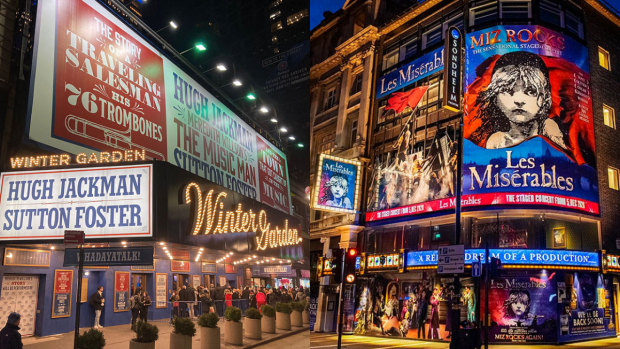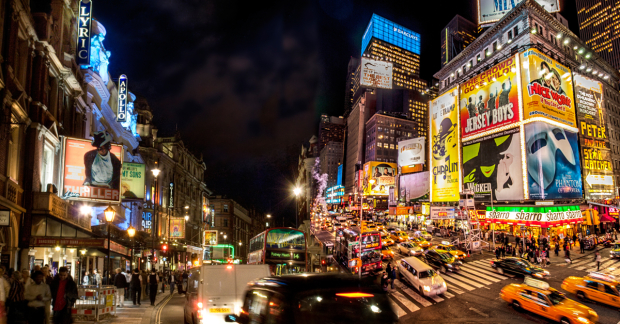What's the difference between seeing theatre in the West End and on Broadway?
We run through some of the niche differences!

© Right: Matt Crockett
Despite theatregoing being a relatively universal pastime, there are some fun differences between experiences in the West End and on Broadway! We weigh them up in our fun feature.
Playbills
Forget spending the pennies on programmes as you might have to in the UK – on Broadway every audience member is entitled to a free Playbill, with cast list, bios, articles (often about other shows also running) and more. It's a great free keepsake – many collect these little yellow booklets for decades.
Mask up
In contrast to the UK, on Broadway there's currently a mask mandate in place – so you have to wear a mask to see shows. Ushers will even remind those closest to the stage to keep their masks in place. Things will, apparently, be changing from July – so masks may be a thing of the past!
Start times
While there are obviously exceptions (Six, Frozen etc spring to mind) the West End has a pretty sturdy timetable – 7.30pm kick off with 2.30pm matinees. On Broadway, you can expect things to be slightly different – matinees usually start at 2pm, with an 8pm evening start time. Even more time for your pre-show meal!

Ready the applause
One of the most striking things going to Broadway recently was how much they love a good clap. Any time a star performer enters the stage, they're met with thunderous applause. Hugh Jackman's "entrance" in The Music Man was practically a show-stop. So get your mitts ready! By the same token, in the West End audiences are generally slightly more reserved – though there's some suggestion UK spectators are slowly sliding in the Broadway direction.
Seating plans
What was a surprise heading from the West End to Broadway was the funky seat numbers. Rather than simply numerical, some Broadway houses put odd and even seat numbers on different sides of the venue, in order to allow the ushers to quickly spot which side to send a punter to. So don't expect a stranger to sit between you and your date if you're in D1 and D3! It's a savvy trick – could the West End do something similar?
Age
Technically there are West End venues older than the USA itself, with Theatre Royal Drury Lane being the oldest theatre site in the West End (a venue was first there in the 1660s). The oldest Broadway venue, however, was built in 1903 – the Lyceum. Which is comparatively young by West End standards!
Capacity
The West End bookends Broadway when it comes to venue sizes. In NYC, the largest is the 1,933-seat Gershwin Theatre, currently home to the blockbuster spectacular Wicked, while the smallest is the 597-seat Hayes Theater. In the West End, the London Palladium is 2,286 seats, while the London Coliseum (sometimes classed as a West End venue) has 2,359 seats. The snug 432-seat Fortune Theatre (home to The Woman in Black) is the smallest. Which brings me onto my next point…

© Andy Bird (CC BY-SA 2.0)/Kevin Poh (CC BY 2.0)
Strict terminology
The New York types like strict definitions! In order for a venue to be classed as a "Broadway" house, it has to have at least 500 seats. Stage 42 (where Kinky Boots is going to play) famously has 499 seats to avoid Broadway classification. There's no such system in the UK, though venues obviously have to be of a certain size in order to be sustainable.
Data
While in the West End producers and venue owners have no duty to disclose their box office earnings (some do when they want to shout about how many records they've broken), in New York the Broadway League dutifully tabulates and releases all the takings from each show in a Broadway house. It can be a fascinating insight into the economics of the Great White Way, while you can also see which shows may be suffering (and possibly most likely to have ticket offers!).
Understudies
The rules for announcing understudies (very much one of the concrete pillars keeping the theatre world afloat right now), varies considerably. While in the West End there is no obligation to announce the presence of understudies (often digital cast boards take care of this), in the US a pre-show announcement or a slip of paper in a Playbill is mandatory. Not only that – if a leading performer (say Hugh Jackman in The Music Man) with their name above the title is off, then audience members are entitled to a refund. It's very technical!
What's in a name?
The auditoria have different parts, and different names. An easy guide for anyone who needs help – stalls = orchestra, circle = mezzanine. Funnily, not many Broadway houses have a second balcony!












